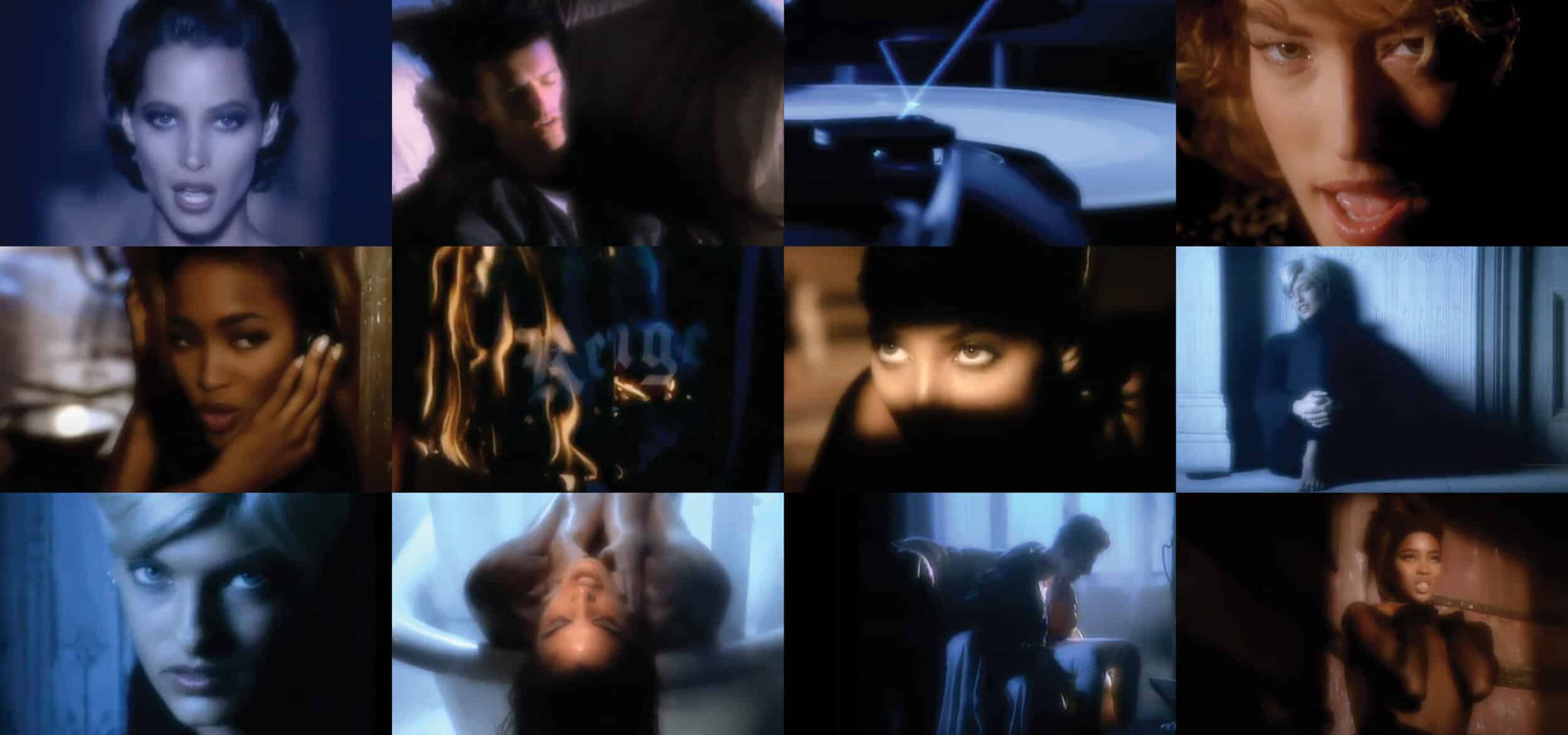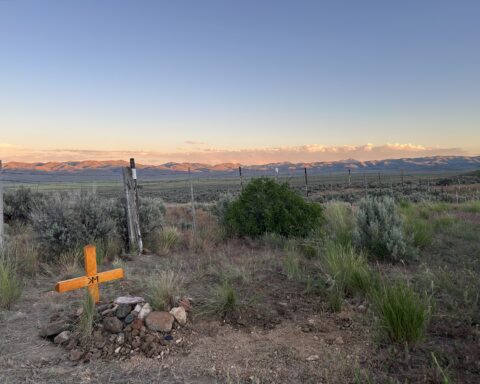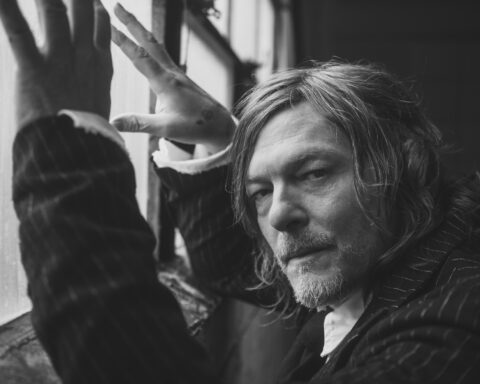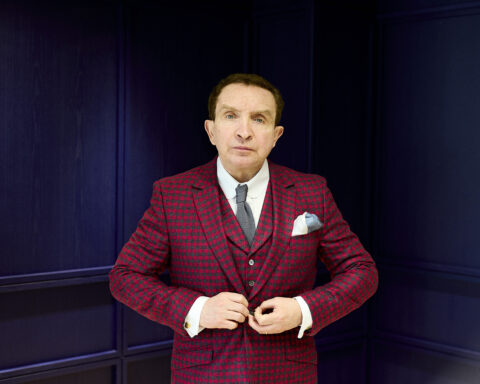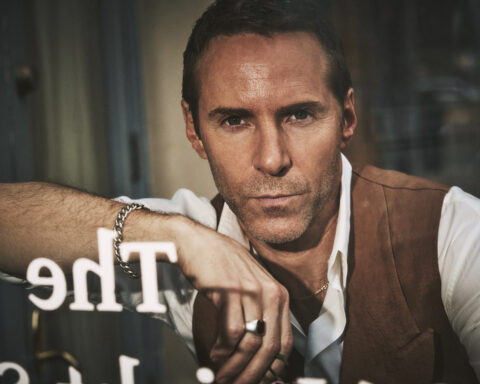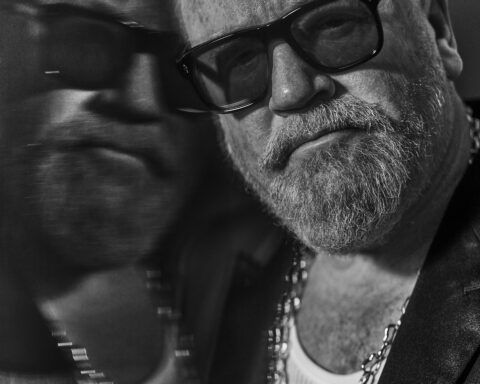It’s hard to believe that it’s 30 years since George Michael’s legendary ‘Freedom! ‘90’ music video was shot and released to the world. It seems as popular and iconic today as it was three decades ago. I marvel at the magic of George creating a song that was personally cathartic for him and just so damn danceable for the rest of us.
Being one part of this captured moment in time was a privilege, and the video irrevocably marked the ultimate synthesis of music and fashion. Amidst an ongoing conflict with his record company and a growing fatigue of fame, George didn’t want to appear in his own video. He had seen the January 1990 issue of British Vogue – where Peter Lindbergh had photographed Naomi Campbell, Linda Evangelista, Tatjana Patitz, Christy Turlington and Cindy Crawford on the cover — and so instead, he famously had the idea that these five stars would be the faces of the song.
I asked Chris Owen and Carole White, founders of Premier Model Agency in London, to recall how it all came about. Their colleague, Becky Peach, was dating one of George’s songwriters at that time, and asked if Chris could join a meeting with George to discuss the video. Pre-production and casting slipped into gear. Even though Premier did not represent all the girls, Chris and Carole still managed to secure all their bookings which, in the competitive world of agencies, was quite the coup. Carole also managed to throw myself and the now-famed fashion photographer Mario Sorrenti in there for the main male roles.
“To get that crew into that video at that time was an awesome feat,” says Chris. “It was a combination of good agenting, and an absolute confidence and belief in what we were putting out. It was such a landmark video, hard to beat, and helped to create the whole supermodel era.” It took about a month to negotiate and sign off. As Carole said, “It was such an amazing film to be a part of — it has never dated and it never will.”
I was fortunate to be in such esteemed company. Along with the girls on screen, a young David Fincher was director — with George never far away and fully focused — and there was a stellar glam team of Guido Palau on hair, Carol Brown on make-up and Camilla Nickerson styling.
I knew and had worked with all the girls several times before, so the run up to this particular gig was quite nonchalant for me. It was really a question of the logistics of a packed schedule and of there being enough hours in the day. During that period of time, our work lives were regularly quite extraordinary. It was normal to work in New York, London, Paris, Rome and LA all in a week. These experiences were so intense, vital and engaging, it felt like you were surfing a great wave. Then suddenly the shoot ended and your ‘work family’ dispersed, each going their separate ways. And, more often than not, another equally, if not more exciting gig was around the corner. It was an incredible time.
I can’t speak for these ladies, but the impression I always had was that we were all just making the most of our lives which were an ever unfolding rush of bizarre and wonderful moments in the company of incredible creative teams. But we had to keep ourselves on the rails, be professional, and not let it go to our heads. We did our best to raise the bar every single time we stepped in front of a camera and we just committed to always being inventive, present and creative, trusting in ourselves and the talents and integrity of the teams surrounding us. For me, that meant playing the fool, being free, and immersing myself into whatever fantasy we were going for on the day. And nine times out of ten, it was joyous.
These five women were, and remain, incredible human beings, all beautiful, fun, intelligent, creative, kind, entrepreneurial and successful. And, most importantly, all living full lives of passion and purpose. Like the video itself, they have all maintained that wonderful energy for three decades. To have shared this moment with them, us all bound in a foot stomping, funky celluloid history set to a great singer-songwriter’s song of escape, is a special thing. And not too shabby for a young lad who came from a council estate in Yorkshire.
So given it’s three decades and I wished to celebrate the launch of our Mr Feelgood platform with something fun, interesting and uplifting, I reached out to the girls to discuss our memories of the shoot and how we, and the world around us, have evolved over the last 30 years.
Watch the ‘Freedom! ‘90’ video // 📸: Sony Music Entertainment / YouTube
JOHN PEARSON:
I remember going through the song with George in his trailer before the shoot and him forgetting some of the words which had us laughing. I think we’d all had a little wine by then! What is your favorite memory of the shoot? And of George in particular?
CINDY CRAWFORD:
My favorite memory was sitting on a plane on my way to shoot it, listening to the song over and over on my Walkman, trying to learn the words. I instantly loved the song and was excited to be included. My favorite memory with George was when we presented together at the MTV VMAs in 1991. It was fun to reconnect in a public setting after the success of the video and have fun with that and each other.
CHRISTY TURLINGTON:
Linda and I were the only ones who overlapped shooting the video because we had a scene together. It was pretty controversial in retrospect as we were pricking our fingers to be blood sisters at a time when HIV AIDS was rampant. I remember George being incredibly focused and in control of everything, but also fun in the moments when we got to just hang out.
LINDA EVANGELISTA:
One of my favorite memories of shooting the video was George explaining to me that I needed to “lip sync” and not sing along to the track. I wasn’t quite sure what the difference was! He was such a sweetheart. We were a bit naughty off set though as the day went on into late night, that’s all I’ll say…
TATJANA PATITZ:
I loved how creative it was. David Fincher was amazing to work with, and I loved all of it! It was a day that I will always remember.
NAOMI CAMPBELL:
The whole thing of listening to the song before and liking it, loving it actually. [I] never imagined in my wildest dreams that we would all be together, singing it, lip syncing it and working with George Michael and the great David Fincher. I remember we had the Thierry Mugler show the night before in Paris and I was the first up to shoot. The show finished at 3am, so I didn’t sleep because I had to catch that 6am plane. There were no Eurostars then going to London and I was exhausted. But I was very much looking forward, just [relieved] that I didn’t have to learn the words because I knew the song.
JOHN:
It was probably the most spoken about job of my career. I remember being in a bar in Miami doing a shoot when the premiere came on MTV. I was excited to see the final cut, and wondering if I’d been edited out. But then it came on and I was ‘singing’ the first line … all the crew around me went crazy. Since then I have never heard a negative thing about it — it seems universally loved. Why do you think this video, more than any other, has had such a lasting impact and has become so iconic? And what effect did it have on your life and career?
CINDY:
I think this video struck a chord for so many reasons. First and foremost was the song itself and the message and declaration of “freedom” for George himself. It also coincided with the “birth” of the supermodel and brought music and fashion together in an exciting way. At the time, I’m not sure I realized the longevity and impact of this video, but obviously, it’s still a favorite.
CHRISTY:
I think the video captures everyone involved at critical junctures in our lives and careers, which none of us could have possibly grasped in the moment, except for George maybe. David Fincher had worked on other iconic videos but this was probably one of the last before his movie making career really took off. The song was an instant classic. Whenever it gets played in a room I am in, I feel eyes turn on me.
LINDA:
First of all, it’s a great song and pure George Michael. I think the video has had such a lasting impact is because EVERYONE has sung along to a song, imagining they were the artist. The video captures that feeling, and that feeling is timeless. For me, the effect of appearing in the video was that I was suddenly known outside of the fashion world and in other media that didn’t pertain to fashion. That was incredible.
TATJANA:
It represents an era in pop culture, and it was at the height of the early 90’s when the fashion, film and music industries blended together. MTV was huge at the time with all the incredible music videos. I became more recognizable in a different way I think.
NAOMI:
It was the first of its kind, a video where the actual artist themselves is not in it. And so it was a bit weird, but very thrilling at the same time. I feel that it’s part of our era, of all of us, including you John. It’s part of our legacy in a way, a time we can always look back on — a happy, great time. Music videos were the thing and to be in someone’s music video, someone super talented like George Michael, was a big deal! Especially coming from London, I think for us, was an even bigger deal. I loved Wham! And you’ll know, because you were traveling as much as we were, we didn’t have time to really pick up on that stuff. We were constantly on the go, so to really sit back and say, “Oh, we’ve made it.” I don’t think any of us had time. I mean, we just went on to the next gig.
JOHN:
I remember watching Linda’s scene being shot and thinking I was witnessing something rare and original.
Whose scene in the video is your favorite and why?
CINDY:
I remember thinking everyone had a better scene than me. I was bummed I got stuck in the bath tub and then after with a towel on my head! But you don’t argue with David Fincher – even then. When I look back, I think we were all presented in a way that reflected us individually. I had fun two years ago re-enacting it on Lip Sync Battle with Zachary Quinto.
CHRISTY:
I love the scene of Linda where the camera films her singing outside and inside her sweater. She had blonde short hair at that moment and I was watching as they filmed. I loved seeing how they cut it together for the final product.
LINDA:
The video is just so beautiful, it’s difficult to have a favorite scene, but I love when the jacket is set aflame. The symbolizing of destroying the artifice to make space for the realness is beautiful.
TATJANA:
That’s a hard question … everyone’s scenes, love the video, all of it!
JOHN:
As the first ‘supers’, what examples do you think our era of models set for the next generation?
CINDY:
I think the group of us paved the way for this broader ideal of beauty. We all looked different, but looked good together and demonstrated that sometimes 1 plus 1 plus 1 equals 1000!
CHRISTY:
That’s hard for me to answer objectively. We were certainly not the first grouping of models, nor the last. I think we were somewhat symbolic with a change in the industry and culture in the world generally. I am sure you will be able to look back at this period and some models will be symbolic of this period too.
TATJANA:
It’s so different today with social media and technology. There is more inclusivity today which I think is fantastic, so there are more opportunities for future generations.
NAOMI:
I don’t think we were trying to purposely put anything in place. I think with the collaboration of the designers, Gianni Versace, Azzedine Alaia, John Paul Gaultier, Paul Smith, Vivienne Westwood, John Galliano, we all grew up together, we were all learning together. Where we were going, we weren’t quite sure, but we just knew that we wanted to elevate it, and do the best we could, and get to the best place that we could. I think we achieved that because then came the actresses that wanted to come into our world.
JOHN:
I was a little embarrassed by the supermodel tag at first. I always thought of Richard Burton saying he was embarrassed at being an actor and he would rather have been known for playing rugby for Wales.
Do you like being referred to as a ‘supermodel’?
CINDY:
At first I found it silly — as if we wore capes and changed in phone-booths (which I have done by the way), but now the term is used so frequently that I’ve gotten used to it.
CHRISTY:
I do not. I always change the word to model whenever I can.
NAOMI:
I’ve always looked at it as a terminology that the press have to have for us — their way of grouping us together. I don’t look at myself in any type of superhero way, in any way or form. But to have that label, I mean, I don’t hate it. That’s what they call us and I feel now, as I’ve gotten older, that we have to embrace it and be grateful for it, and to use that as a platform for doing what we do individually as we all do different things in the world. So I’m not against it. I didn’t understand it in the beginning, I have to be honest. Why were they so interested in what we’re doing? I don’t think of myself as that. I just think of myself as Naomi, a working model. I understand that they have to put us in these categories, but today everyone’s a supermodel. So when you look at it like that, I’m still Naomi, the working model.
JOHN:
What changes do you see in our industry over the last 30 years? Positive and negative?
CINDY:
The positive changes are all about inclusivity and broadening the idea of what is beautiful. I also think having social media can be a powerful tool, but can also feel like a lot of pressure.
CHRISTY:
It’s hard to say since it’s been so long since I was as immersed. I went back to school at 25 and haven’t worked full-time as a model since. When I do shoot these days it’s usually with old friends who will remark at how different it is now. From my perspective, things have gotten less intimate and fun. There’s less time to be playful and just create. There was always a commercial side to the industry, but it feels that that side kind of took over through the years.
LINDA:
There has been so much diversity in our industry — and I love it, I embrace it, and that’s positive. But there hasn’t been enough. The fashion industry still has so much to do.
TATJANA:
The fashion industry has become much bigger, faster and parts of that are positive, but also negative. There was more time before, days of shooting rather than packing everything into one day. Careers were built and had longevity and now it’s a much faster turnaround, for models at least. I look back at the 90’s with such fondness and it was sort of a ‘golden era.’ Magic happened and felt more artistic, less corporate like today.
NAOMI:
I want to try and stay in the positive. So I feel that diversity is finally being embraced. There’s still lots to do in terms of things to iron out and being in a sense of equality. But I always want to say I’m optimistic and I hope that we will get there. And I hope that [because of] the time that I put into this industry for the next generation, that they don’t have to go through what I went through, or have to fight as hard for that diversity. I’d like to see changes made in the industry of people of diversity, of color to be given a seat at the table.
JOHN:
For me, the greatest thing about modeling was also the hardest thing…. always being on the road, traveling to amazing places, but constantly being separated from family and friends. Occasionally I got tired of being the center of attention, having to perform, always having people paw and touch you, but I also knew I was incredibly fortunate to be in that position so made sure I did not complain.
What is hardest part about being a model, that perhaps people would not realize? And how were you able to cope, mentally and physically, given the intense schedules during your busiest times?
CINDY:
Obviously my life as a model is very different today than it was 25 years ago. I think the biggest challenges back then were all the travel, although that’s sometimes the best part of the job as well. I do value my midwestern upbringing and maintaining those relationships with my mother and sisters. Checking in with them always kept me grounded. As my life evolved and I started my own family, prioritizing that help put my career in perspective.
CHRISTY:
The best thing about the job for me was the travel and people I got to meet around the world. I have continued to nurture and develop many of those relationships over the years. But the travel and pace can take a toll as well. I found early on that making time for myself in between jobs and busier seasons was essential. I also started a yoga and meditation practice early on which gave me tools to choose from when I needed them most.
TATJANA:
The hardest part for me was all the traveling and hardly any time off. Waking up in different cities constantly and being pulled in different directions. I was always very sensitive to energy and the stress was hard for me. I found balance in my life when I could retreat and recharge in California, where I moved to in 1988. Practicing Kundalini Yoga and meditation [since] 1993 was also a huge part of that, as well as my horses and pets, and to recharge in nature.
NAOMI:
I don’t feel there was any hard part. It’s just, in our case, you have to adjust and adapt very quickly. Yes, I traveled a lot, at a fast pace, in one week, like you have. But I love traveling, so I can’t complain about it. I think people forgetting maybe sometimes that we’re human? I feel like I was blessed and protected in such a way. Azzedine Alaia, Gianni Versace, Yves Saint Laurent… I felt like I was protected by these designers, and by my friends you’ve included here [in this interview]. I mean, yes, of course I would cry sometimes and be like, ‘I can’t do it. I can’t, I’m exhausted. I want to sleep.’ But then once you got me on set … I’ve forgotten all of that. And you just wanted to just do what you can do the best you could do it.
JOHN:
I’m an independent, leader type personality but, in the absence of a father, I wish I had turned more to others for help and guidance, to share the pressures, rather than everyone come to me for counsel at such a young age. If I could do it all again, I’d probably tell myself not to be afraid to be vulnerable. What advice would you give yourself now if you could go back 30 years?
CINDY:
If I could go back and give my young self advice, it would be to say yes more — or at least not to say no from fear — especially fear of failing.
CHRISTY:
I don’t know that I would have done anything much differently. So much of the learning early on informed my life’s path and where I am today, doing what I love, leading a non-profit. I founded Every Mother Counts in 2010. Our mission is to make pregnancy and childbirth safe for every mother, everywhere.
TATJANA:
Don’t worry so much!
NAOMI:
I felt like I did it with stepping stones. You would see me for a minute and then I’d disappear for a minute. And I feel, in a certain way, I still do that. In the end, I truly always chose the things I wanted to do and the things I didn’t. And I feel like I have no regrets of always opening my mouth and standing up for myself, even though it was be perceived as being difficult back then, when today it’s what everyone’s doing. I don’t have any regrets about that. So I think the speaking up part was important for me then, as it is for me now. You have to remember, we are depicted for what we look like, but it’s also [hard] not knowing how not to take it personally, to [not let it] affect you as a person. It’s not who you are. What they think, or what you may not fit the mold of, doesn’t mean that you’re not a good person.
JOHN:
I was never really asked if I always wanted to be a male model. No, of course not! I always wanted to be an actor, I wanted to be Richard Harris, Richard Burton, Peter O’Toole! The modeling sort of happened by accident, and I just rode the wave. I certainly didn’t expect it to last over these 30 years. I wanted to travel, and I wanted an adventurous life, and I’ve certainly had that. I don’t have any regrets at all, but on the other hand, I’ve never been ok with modeling defining my life. I’m just getting started. You must have been interviewed a thousand times. What question are you never asked that you wish you could answer?
NAOMI:
‘How do you feel? How do you feel?’ I know sometimes people just look at us as… I don’t know… as this public persona. I don’t think they realize that we are human and have feelings just like everybody else. And I guess that’s because they see us in a magazine or on a billboard or whatever, and maybe forget that that’s us at our work, but it’s not us as who we are as people.
LINDA:
There’s not a particular question that I wish I could answer, but it’s always a bit disheartening that I can talk and talk about working to advance work to support breast cancer research, to support LGBTQ rights, to fight AIDS and support elephant conservation efforts, and then it always goes back to more gossipy answers.
JOHN:
Can you share a personal story that you feel would benefit others to hear right now in these difficult times?
CHRISTY:
I have experienced personal loss during this time, but also have been able to directly support frontline health workers and marginalized communities through Every Mother Counts, which has been meaningful and helped me through this period. This is a time to take stock and if you are not feeling moved to action in some way already, there is no better time to reevaluate what you do and how the your actions and words impact the lives and well-being of others.
TATJANA:
The uncertainty during these times is intense to say the least. It’s very stressful on many levels. Spend time in nature, connect to friends and family often. There are good days and bad days so be gentle with yourself. I’ve certainly felt that and it’s been hard to be creative at times figuring out a new normal. The biggest thing for me is to be gentle, in staying healthy and well, and in helping others.
NAOMI:
Oh my goodness. I think most important right now in these difficult times is to keep a healthy, positive mind and spirit. Mental health was always important but some countries erase it more than others, so I feel like the world is now embracing that and realizing how [crucial care] is with what we’re going through right now. You’ve got to get the ego down and you’ve got to stay up, and you’ve got to stay in the light. So whatever it is that you need to do to keep yourself in that light, you have to do it. And it’s easier said than done, I know. But you can’t go down right now. We have to stay positive and know that we will get through this. I know it’s cliche, but we will.


